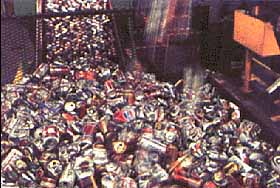Recycling and Scrap Melting: R&D Trends

Courtesy of the Aluminum Association.
Equipment
Combustion Technology
Energy Consumption
Process Description
R&D Trends
The majority of recent R&D has been focused on increasing the efficiency of the aluminum melting process and reducing NOx emissions from aluminum melters. These efforts include developing improved burners, recuperators, low NOx burners and oxy-fuel burners, and new furnace designs. The electric industry has also been focused on developing electric melting equipment that is more competitive with natural gas fired equipment.
HRS Combustion System
Nippon Furnace Kogyo Ltd., has developed an advanced regenerative burner system which is capable of preheating combustion air to 1800°F. A pair of High Cycle Regenerative (HRS) burners alternate operation at 30 seconds intervals. At furnace temperatures close to 2300°F, less than 100 ppm NOx (at 0% O2) can be maintained due to the “unique two stage combustion technology.” Energy savings from 30-60% are reported.
FDI Regenerative System
The Fuel Direct Injection Regenerative (FDI) System is an energy saving, low emissions burner system developed by Tokyo Gas Co., Ltd., and currently being marketed by North American Burner. The heat from the flue gas is captured in alternating regenerators to achieve air pre-heat temperatures over 1800°F. NOx levels below 100 ppm (at 11% O2) can be achieved.
PYRETRON Combustor
American Combustion, Inc. has developed a new burner which is designed to increase convective heat transfer to scrap and decrease NOx and CO emissions. The burner is designed to increase aluminum and brass scrap reclamation. NOx emissions are reported to be about 0.05 lbs./MMBtu.
Electric Aluminum Melter
EPRI, Centerior Energy, TVA, and Alabama Power are currently funding the development and demonstration of an advanced dc plasma electric aluminum melter. The unit is designed to compete with gas-fired reverberatory melters. The unit is reported to competively priced with gas-fired equipment, is 70% efficient, and produces more aluminum than comparably sized gas-fired units. The unit is projected to be commercially available by the summer of 1996
